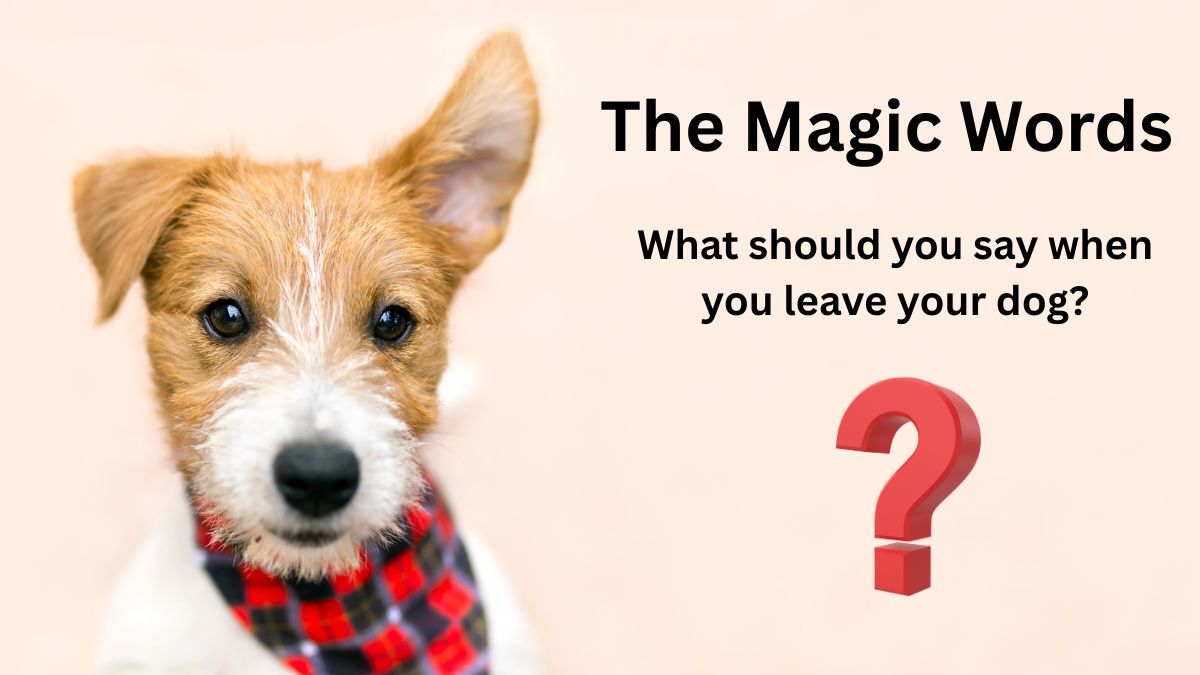The Magic Words: What should you say when you leave your dog?

Leaving your dog at home alone can be a stressful experience, both for you and your pup. But with the right approach, you can make this easier...
Leaving your dog at home alone can be a stressful experience, both for you and your pup. But with the right approach, you can make this transition smoother for both of you. In today’s post, we'll dive into what you should say and do when you leave your dog alone at home.
The Power of Words: What to Say
First, let’s address one common question: Do you need to say anything when you walk out the door? Technically, no. You can leave quietly and calmly, but if you prefer to say something, it’s important to choose words that make you feel positive about the situation. Why? Because your energy matters. If you feel anxious about leaving, your dog will likely pick up on that and may become anxious too.
This is where the idea of "magic words" comes into play. A “magic word” is a phrase you say to your dog that helps you feel good about leaving. It should be something that puts a smile on your face and helps you stay relaxed. The key is to make sure it’s a positive and confident cue for both you and your dog. For instance, you could say something silly or fun like “Abracadabra,” “Bananas,” or “Cheerio, old chap!” (one of my former clients said this!) —something that’s lighthearted and doesn’t trigger any anxious feelings for either of you.
By using a phrase consistently when you leave, you can help your dog build a positive association with your departures. Over time, your dog will understand that when they hear this word, it's not something to fear—it's just you leaving, but they’ll be safe.
Avoid Anxiety and Stay Calm
I’ve worked with many clients who get a bit anxious as they approach the final step in their dog’s training. As you work on gradually increasing the time your dog is left alone, it’s natural to feel a bit worried about how your dog will handle it. However, it’s crucial to remember that your anxiety can transfer to your dog. If you’re tense, your dog might also feel uneasy.
So, what can you do to stay calm before walking out the door? There are a few techniques that can help.
- Deep Breathing: Taking a few slow, deep breaths before you leave can help calm your nerves and reset your emotional state.
- Calming Music: You can play calming music to help both you and your dog relax. Just make sure to introduce the music outside of your training sessions first, so your dog associates it with calm, restful time—not playtime.
- Grounding Exercises: If you’re feeling a lot of stress, try grounding yourself. Take a moment to connect with the present, breathe deeply, and release any tension you might be holding in your body.
- Standing Forward Fold: You don’t have to be into yoga to try this! Simply stand up, bend at the waist, and let your head hang down, allowing the blood to rush to your head. This can help calm your nervous system and clear your mind. It’s a great way to release any pent-up anxiety before you leave.
What to Do with Dogs Who Can't Hear You
If your dog is blind or deaf, you may be wondering how to communicate your departure. For blind dogs, you can use a visual cue, like tying a brightly colored ribbon on a chair or leaving something on the counter that signifies you’re leaving. For deaf dogs, you can use a scent cue—a specific scent they only encounter when you’re about to leave. You could also try a light touch or vibration as a way of communicating your departure without startling them.
Training Your Dog When They’re Sleeping
Sometimes, you might need to leave while your dog is sleeping. While it's tempting to sneak out when they’re peacefully snoozing, that can actually backfire. If they wake up and realize you’ve disappeared, it can lead to anxiety and confusion.
Instead, gently wake your dog by giving them a light touch or soft stroke. This lets them know you’re about to leave without startling them out of sleep. Once they're aware, you can leave calmly and quietly, knowing they’re not waking up to a surprise.
Final Thoughts
Leaving your dog home alone doesn’t have to be a stressful experience for either of you. By choosing the right words, staying calm, and using positive cues, you can help your dog feel confident and safe while you’re gone. Whether you use magic words, calming music, or grounding techniques, the goal is to ensure your dog’s time alone is as peaceful as possible.
Remember, consistency is key. With the right training and approach, you can make departures—and returns—much easier for both you and your dog.
 Ness Jones
Ness Jones 
